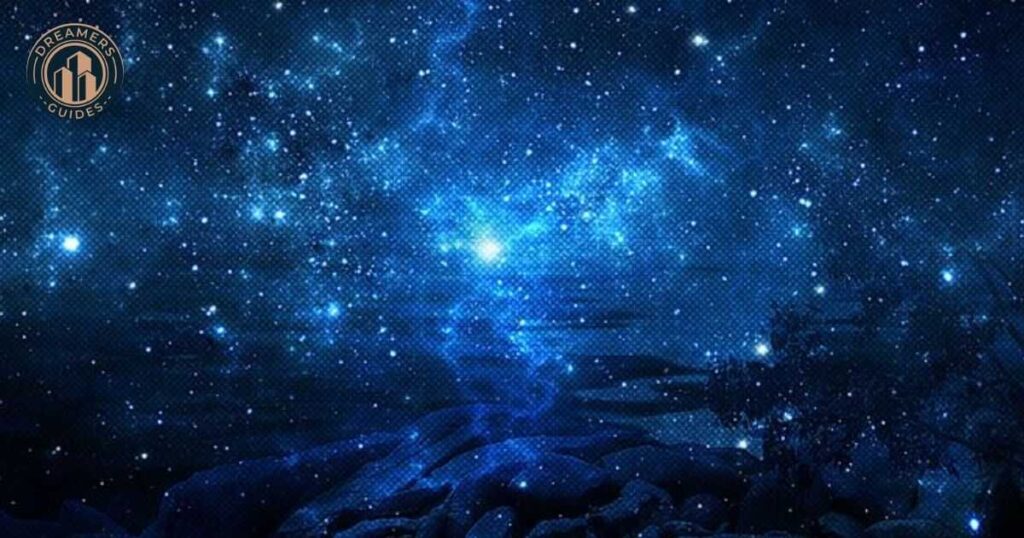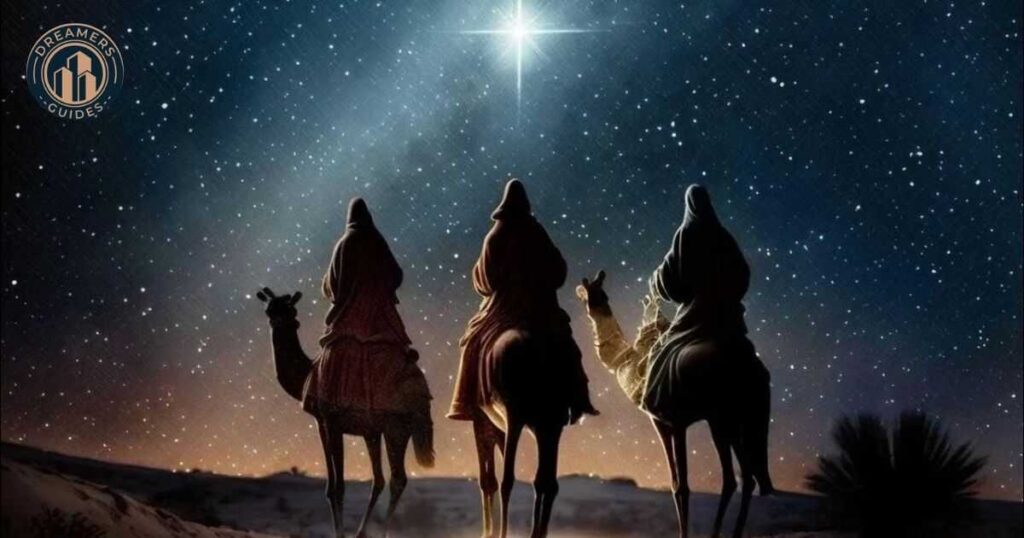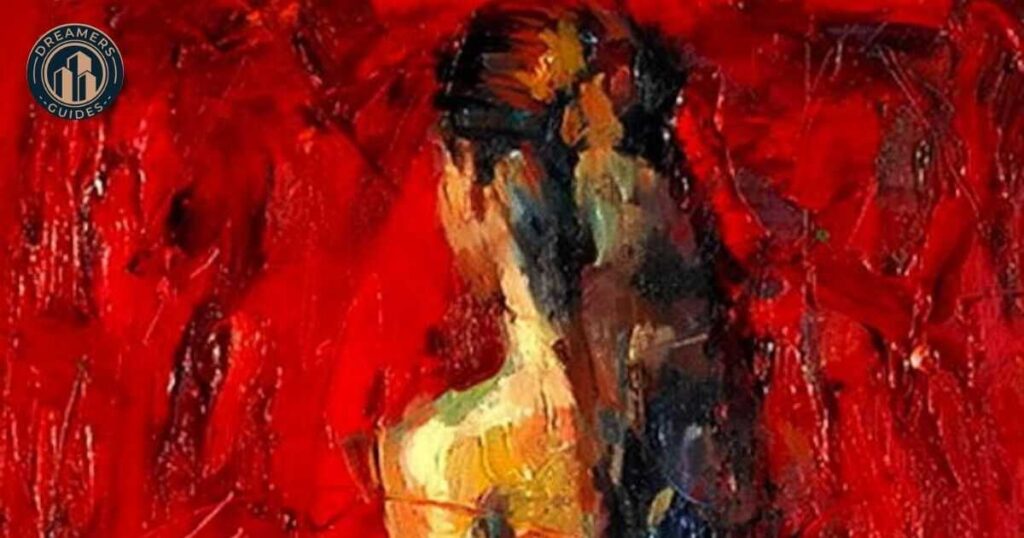Stars have been a constant source of inspiration for artists, storytellers, and spiritual leaders throughout history. From ancient cave paintings to modern-day logos. Let’s dive into the fascinating world of star symbolism and explore how these celestial beacons have left their mark on civilizations around the globe.
In architecture, stars often adorn the ceilings of temples and palaces, creating a sense of cosmic connection. Take the ceiling of Grand Central Terminal in New York City. Similarly, Islamic art frequently uses intricate star patterns, symbolizing the infinite nature of Allah.
Twinkling Tales
Ever gazed at the night sky and felt a spark of wonder? You’re not alone. For thousands of years, stars have captivated humans, shaping our art, beliefs, and cultures.
General Meaning of The Star
Stars hold a multitude of meanings across different cultures. They’re seen as guides, symbols of hope, and connections to the divine. Let’s break down some of the most common interpretations of these celestial symbols.
Think of stars as nature’s Swiss Army knife they’ve got a tool for every symbolic job. Whether you need direction, inspiration, or a touch of magic, stars have got you covered. It’s no wonder they’ve stuck around in our collective imagination for so long!
1. Guidance and Navigation
For centuries, sailors have looked to the stars to find their way across vast oceans. The North Star, or Polaris, has been particularly crucial for navigation in the Northern Hemisphere. It’s like nature’s own GPS system!

Polynesian navigators took star-guided sailing to a whole new level. They memorized the positions of hundreds of stars, using them to sail across thousands of miles of open ocean.
Talk about having a good sense of direction! Today, while we have GPS, the concept of stars as guides still resonates in our culture. Just think of phrases like “follow your North Star” when talking about life goals.
2. Hope
When life gets tough, people often look to the stars for comfort. These distant lights, shining through the darkness, remind us that there’s always a glimmer of hope, no matter how dark things seem.

The phrase “reach for the stars” encourages us to dream big and aim high. It’s a reminder that even if we fall short, we’ll still have accomplished something great. Stars in this context symbolize our highest aspirations and the belief that we can achieve them.
3. Divine and Spiritual Connection
Many cultures see stars as a bridge between the earthly and the divine. In Christianity, the Star of Bethlehem guided the Wise Men to the birthplace of Jesus. This celestial sign marked a moment of profound spiritual significance.

In Hinduism, stars are often associated with deities. The Nakshatras, or lunar mansions, are groups of stars thought to have divine influence over human affairs. Similarly, in Native American traditions, stars are often seen as the souls of ancestors watching over us from the heavens.
Read More About : White Aura Meaning: The Ultimate Guide
4. Achievement and Success
We use stars to rate everything from hotels to movies, making them a universal symbol of quality and excellence. A five-star review is the ultimate stamp of approval in our modern world.
In the military, stars on uniforms denote rank and achievement. The Congressional Medal of Honor, the highest military decoration in the United States, features a prominent star design. These stellar symbols serve as a constant reminder of the wearer’s valor and service.
5. Fame
When we call someone a “star,” we’re not talking about their astronomical properties! This term has become synonymous with fame and celebrity. The idea of stars as symbols of fame likely comes from their stand-out quality in the night sky.

Hollywood’s Walk of Fame takes this symbolism literally, with celebrity names emblazoned on star-shaped plaques. It’s a tangible representation of “reaching for the stars” in the entertainment industry. Next time you see a star on a dressing room door, you’ll know exactly what it means!
6. Beauty and Wonder
Artists have long been inspired by the beauty of a starry night. Vincent van Gogh’s “The Starry Night” is perhaps one of the most famous artistic interpretations of the night sky. Its swirling stars capture not just the visual beauty of the heavens, but also the emotional impact of gazing up at the cosmos.
In literature, stars often symbolize beauty and wonder. Shakespeare frequently used star imagery in his works. In “Romeo and Juliet,” he famously describes the lovers as “star-crossed,” tying their fate to the celestial bodies above. Modern authors continue this tradition, using stars to evoke feelings of awe and possibility in their readers.
Star Symbolism in Mesopotamia
In ancient Mesopotamia, the cradle of civilization, stars played a crucial role in daily life and religious beliefs. The Sumerians, Babylonians, and Assyrians were keen observers of the night sky, developing complex systems of astronomy and astrology.
The Mesopotamians saw the stars as divine beings, each representing a different god or goddess. The planet Venus, for example, was associated with Ishtar, the goddess of love and war.
This celestial connection to the divine influenced everything from religious rituals to political decisions. Kings would often consult astrologers before making important choices, believing the stars held the key to their fate.
Star Symbolism in Egypt
The ancient Egyptians had a deep connection with the stars, particularly Sirius. This brightest star in the night sky played a crucial role in their agricultural calendar. Its annual reappearance just before sunrise (called the heliacal rising) signaled the coming flood of the Nile River, vital for crop growth.

But stars weren’t just practical tools for the Egyptians they were also integral to their beliefs about the afterlife. The pharaohs aligned their pyramids with certain stars, believing this would help them ascend to the celestial realm after death.
Talk about planning ahead! This cosmic connection shows just how deeply stars were woven into the fabric of Egyptian culture and religion.
Read More About : Spiritual Meaning of Water
Star Symbolism in Greek Mythology
Greek mythology is a treasure trove of star stories. The Greeks saw the night sky as a grand tapestry telling tales of gods, heroes, and mythical beasts. Many of our modern constellation names come from these ancient myths.
Take Orion, for example. This prominent constellation was said to be the great hunter of Greek legend, placed in the stars by Zeus. The Big Dipper was seen as part of Ursa Major, the Great Bear, tied to the myth of Callisto and her son Arcas.
These stories weren’t just entertainment they helped people remember the positions of stars, aiding in navigation and timekeeping.
Symbolism of the Stars in Taoism
In Taoism, an ancient Chinese philosophy and religion, stars play a significant role in understanding the cosmos and one’s place within it. The Taoists saw the night sky as a reflection of the earthly world, with celestial events mirroring and influencing terrestrial affairs.
One of the most important star groups in Taoism is the Big Dipper, known as the Northern Dipper or Beidou. This constellation is seen as a cosmic axis, around which the heavens revolve. Taoist priests often incorporate star-walking rituals.
Mimicking the movement of celestial bodies, as part of their spiritual practices. These rituals are believed to align the practitioner with cosmic energies and promote harmony between heaven and earth.
Symbolism of the Stars in African and Indigenous Cultures
Across the vast continent of Africa, stars have played a crucial role in navigation, timekeeping, and storytelling. The Dogon people of Mali, for example, have an intricate cosmology that includes detailed knowledge of the Sirius star system, passed down through oral tradition for generations.
In many African cultures, stars are seen as the eyes of ancestors watching over the living. The Pleiades star cluster, known as “isiLimela” in Xhosa culture, was used to mark the beginning of the planting season. This shows how celestial observations were deeply intertwined with practical aspects of daily life.
Star Symbolism in Literature
Literature has long been in love with the stars. From ancient epics to modern novels, authors have used stellar imagery to convey deep emotions, grand ideas, and the mysteries of existence.

Shakespeare, the master of English literature, frequently employed star symbolism. In “Julius Caesar,” Cassius declares, “The fault, dear Brutus, is not in our stars, but in ourselves,” challenging the idea of predetermined fate.
Fast forward to modern times, and we see John Green’s novel “The Fault in Our Stars” playing with this same concept, using celestial imagery to explore themes of love, loss, and destiny.
Conclusion
As we’ve journeyed through the vast expanse of star symbolism, it’s clear that these twinkling celestial bodies have left an indelible mark on human culture. From the intricate star mapping of ancient seafarers to the profound spiritual insight sought by stargazers, stars continue to captivate our imagination and shape our understanding of the world.
The cultural significance of stars spans across continents and millennia. In Greek mythology, constellations weave tales of gods and heroes, while African cultures use stellar patterns to guide agricultural practices. This cultural heritage demonstrates the universal appeal of these distant lights, bridging diverse traditions and beliefs.
Stars have served as beacons of hope and divine connection, offering comfort in times of darkness and a sense of sacred bond with the cosmos. They’ve inspired countless works of art and literature, from Van Gogh’s swirling night skies to Shakespeare’s celestial metaphors. This literary symbolism reflects our enduring fascination with the heavens and our quest to understand our place within them.
Read More : Feather Symbolism & Meaning: Ultimate Guide
Modern World
In our modern world, stars continue to symbolize achievement and success. Whether it’s a five-star review or a stellar performance, we still reach for the stars in our pursuit of excellence. This cosmic symbolism has seamlessly transitioned from ancient spiritual symbols to contemporary markers of quality and fame.
As we gaze up at the night sky, we’re not just seeing points of light, but a rich tapestry of human history and imagination. The stars remind us of our ancestral wisdom, our quest for knowledge, and our dreams of exploration. They connect us to our past while inspiring us to push the boundaries of space exploration.
In essence, the symbolism of stars across arts and cultures is a testament to the human spirit’s endless curiosity and creativity. It’s a reminder that no matter where we come from or what we believe, we all share the same starry canopy above.
So next time you look up at the night sky, remember you’re not just seeing stars, you’re witnessing millennia of human wonder, spiritual awareness, and shared cultural heritage.

James Michael
James Michael is the creative force behind Dreamers Guides, dedicated to exploring the rich symbolism and spirituality of diverse cultures. With a passion for uncovering ancient wisdom, He crafts insightful narratives that connect beliefs and foster understanding among readers worldwide.